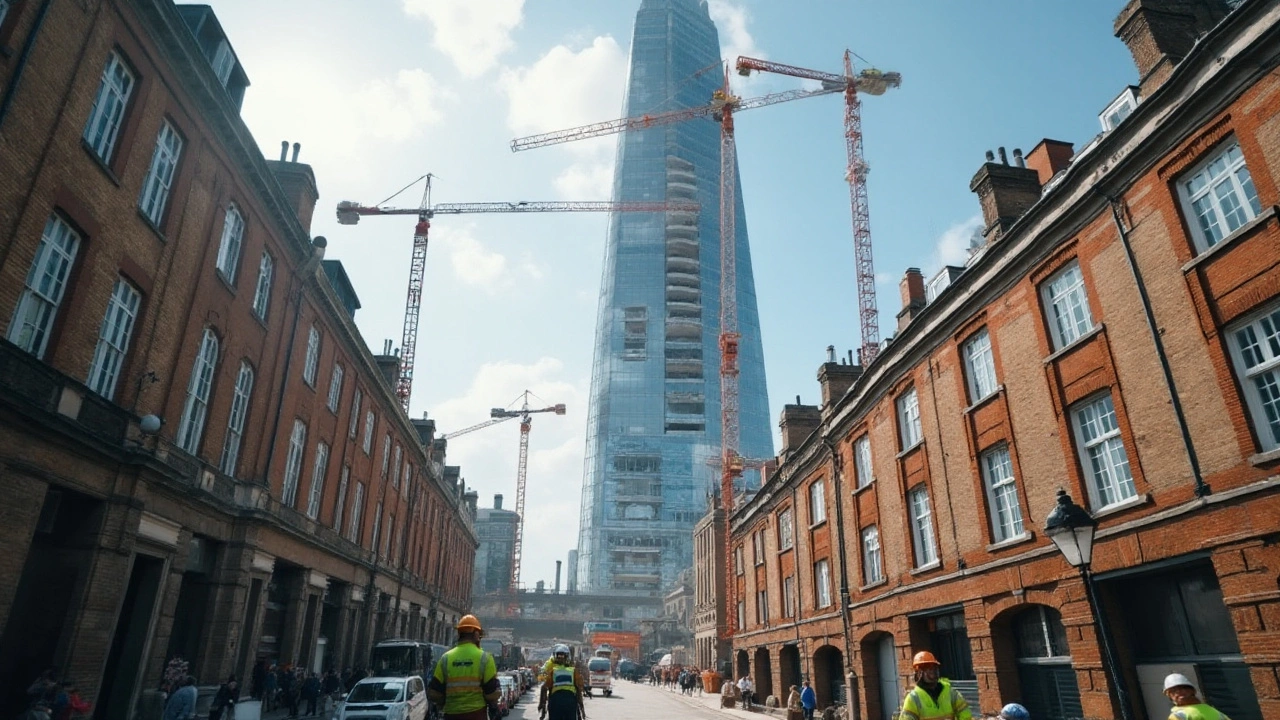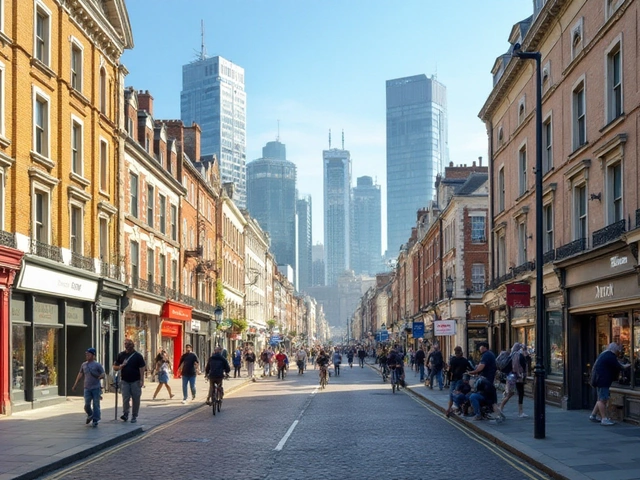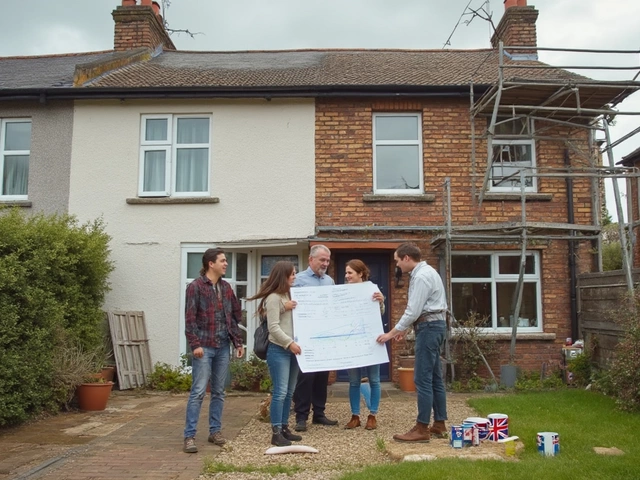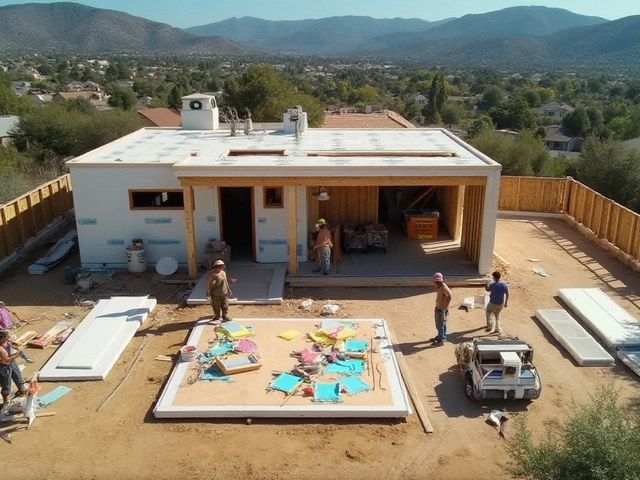Construction is a dynamic field that bridges dreams and reality, bringing to life everything from skyscrapers to intimate homes. The stark distinction between commercial and non-commercial construction is a foundational aspect of the industry that often gets overlooked. This guide will help to unravel these differences, offering a clear understanding of what defines commercial versus non-commercial projects.
Understanding these categories is more than just semantics; it shapes the approach to design, compliance, and financial planning. Whether you're a seasoned developer or embarking on your first build, getting to grips with these nuances can make or break your project. Join us as we explore these aspects and their implications for construction in today's world.
- Defining Commercial and Non-commercial Construction
- Design and Functional Differences
- Budgeting and Financial Considerations
- Regulatory and Compliance Factors
- The Future of Construction Types
Defining Commercial and Non-commercial Construction
When diving into the realms of building and design, one of the first distinctions to clarify is between commercial construction and non-commercial construction. This differentiation isn't just a matter of academic interest; it directly influences the kind of skills, materials, regulatory requirements, and budgets involved. But what exactly do these terms mean? In essence, commercial construction refers to projects intended for business operations. This might include anything from skyscrapers and office buildings to shopping malls and restaurants. The focus here is largely on functionality, space optimization, and compliance with zoning laws that can support high-density activities.
On the other side of the spectrum, non-commercial construction often centers around residential buildings like houses, schools, and occasionally smaller governmental projects, where the intent isn't to produce direct revenue. These projects might emphasize aesthetics and comfort just as much as efficiency, steering the design discussions toward personal or community preferences. Notably, non-commercial buildings often face different zoning laws and can sometimes benefit from more lenient infrastructure requirements, contingent on the local jurisdiction. Each of these sectors plays an essential role in the way societies are structured and the environments in which people live their daily lives.
Historical Context and Evolution
Understanding the historical context gives us insight into why this distinction has become so pivotal. In the early industrial period, the explosion of urban centers necessitated a new approach to how spaces were allocated and used. Cities burgeoned with commercial centers that catered to manufacturing needs, leading to a division between workspaces and living areas. Today, this evolution continues with modern buildings frequently designed to be multi-use, reflecting the flexible demands of urban life. This complexity has turned city planning into a colossal puzzle where the pieces must fit together seamlessly.
"The separation of residential and commercial districts was driven by the basic need to manage urban growth," says urban planner James Ford. "Yet, as cities evolve, these lines blur, showing a growing trend to integrate spaces for living and work. It's a shift towards a more adaptable lifestyle."
Key Features and Characteristics
The key characteristics that set commercial construction apart also greatly influence the longevity and sustainability of the projects. Commercial buildings often need to comply with energy efficiency standards like LEED or BREEAM, which evaluate the ecological impact of a structure. This means such projects typically boast cutting-edge technology and sustainable materials aimed at reducing long-term operational costs. On the flip side, non-commercial setups might see an intensified focus on natural light, unique architectural styles, or integration with local culture. Considerations here can range from children-friendly environments to elderly accessibility, each tailored to the specific needs of the community or individuals.
| Project Type | Main Focus |
|---|---|
| Commercial | Functionality, Compliance, Efficiency |
| Non-Commercial | Aesthetics, Comfort, Personalization |
Getting a grip on these distinctions helps both constructors and clients navigate the often tangled web of plans and permits. It's not just about the purpose of the building, but about crafting spaces that meet different expectations and provide a harmonious balance between human necessities and environmental responsibilities.
Design and Functional Differences
When examining the landscape of commercial construction versus non-commercial, the differences in design and functionality become apparent right from the blueprint stage. Commercial buildings, often constructed for business purposes, emphasize on maximizing functional space to accommodate various business activities like retail operations, corporate meetings, or industrial productions. In contrast, non-commercial, or residential structures, focus more on comfort, aesthetics, and personal coziness, designed to provide the Italian marble kitchen counters rather than maximizing the number of team meeting rooms.
One notable distinction lies in the structural demands. Commercial spaces typically require a robust construction to support high foot traffic and heavy machinery. This can result in reinforced floors, soundproof walls, expansive multi-level designs, and advanced HVAC systems. These are critical for facilitating ease of operations within a bustling establishment. In contrast, residential buildings prioritize ergonomic designs, incorporating features such as energy-efficient solutions and eco-friendly materials to create a healthy living environment that families can thrive in. As a surprising fact, according to a study by the National Association of Home Builders, nearly 70% of new residential builds now integrate smart home technology.
"Function follows form; this aesthetic principle holds different meanings for commercial and non-commercial construction," noted David Pfeiffer, an architect renowned for his innovative designs in both sectors.
In terms of aesthetics, commercial structures aim for neutrality to appeal to vast demographics and industries. The exteriors may include sleek glass facades and minimalist designs. Internally, there's an emphasis on versatility—open-plan office spaces and customizable retail units come to mind. Meanwhile, residential spaces often reflect personal tastes. Architectural diversity is substantial, ranging from sprawling suburban ranches to high-rises in dense urban areas. The interior accents—think vibrant paint choices, unique layouts, bespoke furnishings—play a significant role in echoing the occupant's personality.
| Feature | Commercial Construction | Non-commercial Construction |
|---|---|---|
| Objective | Maximize Operational Space | Enhance Living Comfort |
| Structure | Reinforced, Durable | Comfort-Oriented, Aesthetic |
| Design Variety | Neutral, Versatile | Diverse, Personalized |
Moreover, technology once considered a feature exclusive to commercial spaces, finds its way into contemporary homes. Smart lighting, advanced security systems, and efficient climate control are now staples in high-end residential properties. A growing trend pushing the bounds of the possible, merging the line that once clearly divided non-commercial construction from its commercial counterparts. The convergence of these innovations signifies a shift in priorities and preferences but also reflects broader societal changes. It's shaping a future where all spaces, regardless of traditional classifications, can be uniquely tailored to satisfaction and need.

Budgeting and Financial Considerations
When venturing into the world of commercial construction, budgeting and financial considerations stand at the forefront of planning. This is an arena where careful fiscal management can directly impact the project's success from inception to completion. A recognized fact in commercial versus non-commercial distinctions is the significant variance in scope and scale. Commercial projects tend to require much larger budgets due to scale, complexity, and the type of materials used. Due diligence in initial budgeting can prevent cost overruns, which are a notorious challenge in the construction industry.
Commercial construction is often associated with greater financial stakes due to larger sizes, more sophisticated designs, and extensive use of specialized technology. Funding for such projects usually comes from investors or financial institutions, expecting a substantial return on investment, which necessitates meticulous financial planning. Costs can rapidly spiral without a detailed plan, underscoring the importance of accurate forecasts and contingency funds. On the other hand, non-commercial projects, such as residential homes, may involve personal financing or smaller-scale loans, with a focus on affordability and functionality.
Key Budgeting Elements
Project managers and developers must account for direct and indirect costs. While direct costs include materials, labor, and machinery, indirect costs encompass permits, unforeseen delays, and compliance costs. An insightful quote from a financial expert at Deloitte states,
"Effective budgeting in construction isn't just about predicting costs but also anticipating potential shifts in market conditions that could impact those costs."It is crucial to incorporate variables such as fluctuating material prices and interest rate changes that can affect loan repayments over the project's lifespan.
Strategies and Tips for Financial Management
Utilizing strategic financial tools can aid in maintaining control over project budgets. Among these, software solutions for budgeting and cost estimation are invaluable. These platforms can keep track of expenses in real-time, providing alerts on budget deviations. Adoption of technology in financial planning allows for transparency and accountability, especially in large commercial projects. Additionally, fostering strong relationships with suppliers can lead to cost savings through negotiated bulk deals or long-term contracts, beneficial for maintaining quality while adhering to budget constraints.
In assessing financial viability, an often overlooked, yet vital piece is the post-construction operational costs that need to be factored in initially. This includes maintenance, utilities, and staffing for commercial properties, which can significantly impact the long-term profitability of a development. Developing a robust financial plan with these elements can be the difference between a project that thrives and one that derails.
Regulatory and Compliance Factors
When embarking on a commercial construction project, understanding the regulatory landscape is crucial. Commercial construction projects must adhere to a myriad of codes and regulations, often more stringent than those applied to non-commercial projects. These rules are in place to ensure public safety, environmental protection, and quality assurance. Building codes will typically dictate capabilities for withstanding elements like wind, snow, or earthquakes, while zoning laws determine what types of structures can be built in certain areas. For instance, a city might enforce different height restrictions for buildings in downtown versus suburban areas, making compliance a critical part of the planning phase.
Failing to meet these standards can result in significant fines, project delays, or even demolition orders. This makes pre-construction research into local and national requirements an absolutely essential step. It's also necessary to interpret and incorporate standards set by bodies such as the International Code Council (ICC) or the National Fire Protection Association (NFPA). For example, adherence to the Americans with Disabilities Act (ADA) ensures facilities remain accessible to all, which is a common requirement that must be met in commercial spaces.
"Regulations are the architecture of trust. Without them, there’s disorder," notes Professor John Ridley, emphasizing the importance of compliance in construction.
Non-commercial projects, such as residential homes, have their own set of standards to comply with, albeit generally less strict than those for commercial buildings. Codes in this context might focus more on energy efficiency and residential safety rather than accommodating large groups or heavy industrial activity. Usually, homeowners work closely with local planning departments to ensure compliance, addressing concerns such as setbacks from property lines and water drainage standards. These elements, though simpler, still hold critical importance for ensuring structural safety and neighborhood harmony.
The permitting process, another key component of construction differences, can vary significantly between commercial and non-commercial projects. Commercial permits often require more detailed plans and longer approval processes due to their scale and impact. A construction project aimed at building a shopping mall will inherently attract more scrutiny than a single-family dwelling, given the potential traffic, environmental, and societal impacts. Preparing for these hurdles in advance benefits project organizers by enabling smoother execution once the green light is given.
Recent data from the U.S. Bureau of Labor Statistics reveals intriguing insights into the regulatory impact on construction timelines.
| Project Type | Average Compliance Delay (Weeks) |
|---|---|
| Commercial | 8 |
| Non-commercial | 4 |
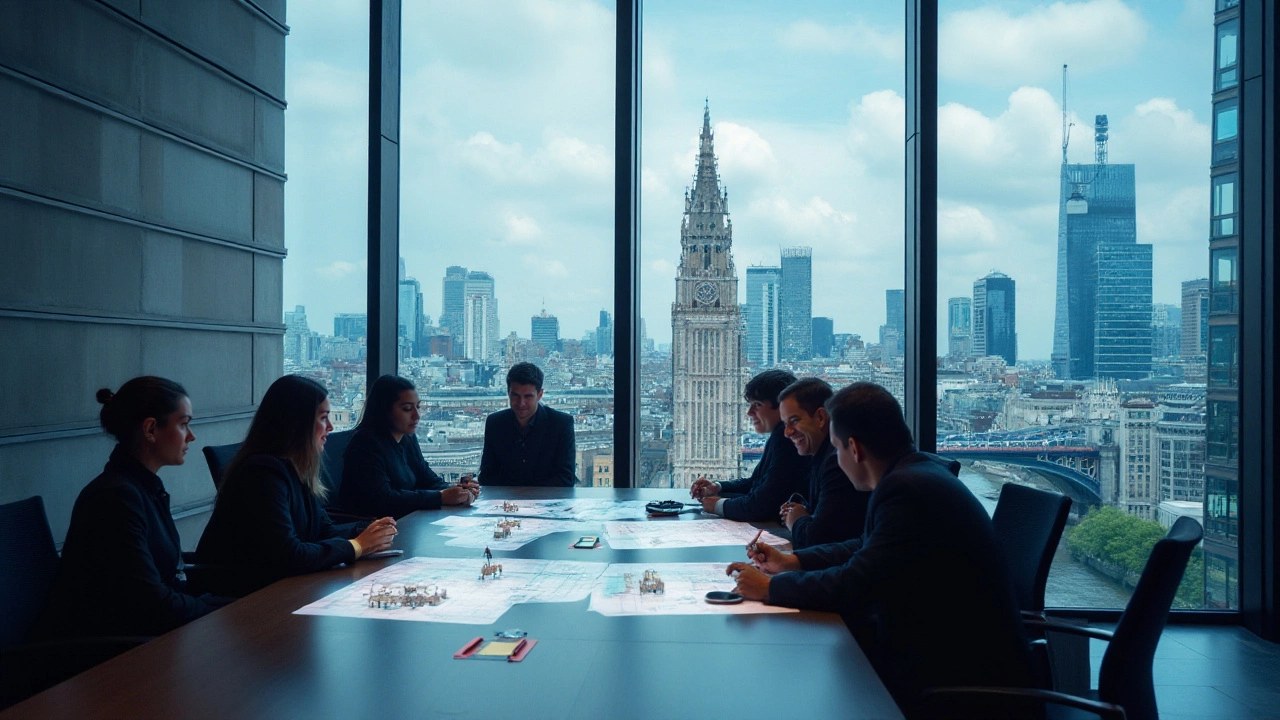
The Future of Construction Types
As the clock ticks steadily towards a future brimming with possibilities, commercial construction and non-commercial ventures are poised for transformation in unprecedented ways. Visionaries in the sector foresee a landscape where technology and sustainability are more intertwined than ever before. In this brave new world, structures evolve not just in function, but also in the role they play within their communities. One cannot discount the impact of burgeoning technologies such as augmented reality (AR) and virtual reality (VR) that are revolutionizing the design and planning phases of building projects. These tools offer stakeholders an immersive experience, allowing them to visualize end-results before the first brick is laid. According to a recent report by McKinsey & Company, digital transformation in construction could lead to a productivity increase of up to 60% by 2030. Such advancements are set to reframe how commercial construction projects are conceptualized and executed.
In tandem with technological marvels, the drive towards sustainability is reshaping priorities. The construction industry, traditionally a significant contributor to environmental concerns, is increasingly adopting green building practices. Materials and methods that reduce carbon footprints and enhance energy efficiency are becoming the norm. The advent of solar-integrated rooftops, energy-efficient HVAC systems, and eco-friendly materials signifies a shift that is both imperative and unstoppable.
"The construction industry is not just building structures; it's building the future," says Jane Doe, a renowned sustainability expert. "Sustainable practices are no longer optional—they are essential."As communities become more environmentally conscious, the demand for sustainable commercial construction solutions is expected to rise dramatically.
The future is also taking shape in the form of modular and prefabricated buildings. These innovations are redefining efficiency, as they allow for the simultaneous progression of design, manufacturing, and assembly processes. Modular construction is particularly relevant for urban environments where space and time are at a premium. This approach not only minimizes waste but also reduces project timelines and costs, making it a viable solution for both commercial and non-commercial projects. A study by the Modular Building Institute highlights that modular buildings can reduce construction time by 20% to 50%. Such efficiencies could redefine cost-structures and timeframes across the industry, marking a new era for both types of construction.
As we peer further into the workings of both commercial construction and its non-commercial counterpart, the role of AI and machine learning becomes increasingly apparent. These tools are not solely confined to streamlining operations; they are also driving innovation in predictive maintenance, safety checks, and project management. The anticipated growth in AI capabilities promises to not only maintain operational integrity but also predict potential issues before they arise, thus averting costly delays and enhancing safety protocols.
Finally, the future of construction embraces inclusivity and diversity. An industry once dominated by conventional approaches is now opening its doors to new ideas and perspectives. Emerging markets and diverse talents are contributing to a rich tapestry of input and innovation. This diversity strengthens sector resilience and fosters a collaborative environment where creativity thrives. The future beckons with promise for all facets of the construction realm, encapsulating a commitment to technology, sustainability, efficiency, and inclusivity as critical pillars underpinning future progress.

